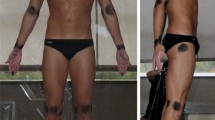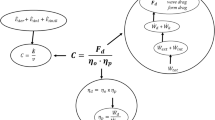Abstract
The aim of this study was to investigate the role of trunk incline (TI) and projected frontal area (A eff) in determining drag during active/passive measurements. Active drag (D a) was measured in competitive swimmers at speeds from 0.6 to 1.4 m s−1; speed specific drag (D a/v 2) was found to decrease as a function of v (P < 0.001) to indicate that the human body becomes more streamlined with increasing speed. Indeed, both A eff and TI were found to decrease with v (P < 0.001) whereas C d (the drag coefficient) was found to be unaffected by v. These data suggest that speed specific drag depend essentially on A eff. Additional data indicate that A eff is larger during front crawl swimming than during passive towing (0.4 vs. 0.24 m2). This suggest that D a/v 2 is larger than D p/v 2 and, at a given speed, that D a is larger than D p.




Similar content being viewed by others
References
Alexander DE (1990) Drag coefficients of swimming animals: effects of using different reference areas. Biol Bull 179:186–190. doi:10.2307/1541768
Arellano R, Terres-Nicol JM, Redondo JM (2006) Fundamental hydrodynamics of swimming propulsion. Rev Port Cien Desp 6:15–20
Chatard JC, Lavoie JM, Burgoin B, Lacour JR (1990a) The contribution of passive drag as a determinant of swimming performance. Int J Sports Med 11:367–372. doi:10.1055/s-2007-1024820
Chatard JC, Bourgoin B, Lacour JR (1990b) Passive drag is still a good evaluator of swimming aptitude. Eur J Appl Physiol 59:399–404. doi:10.1007/BF02388619
Clarys JP (1979) Human morphology and hydrodynamics. In: Terauds J, Bedingfield EW (eds) Swimming III. University Park Press, Baltimore, pp 3–41
di Prampero PE, Pendergast DR, Wilson D, Rennie DW (1974) Energetics of swimming in man. J Appl Physiol 37:1–5
Gourgolis V, Aggeloussis N, Kasimatis P, Vezos N, Boli A, Mavromatis G (2008) Reconstruction accuracy in underwater three-dimensional kinematic analysis. J Sci Med Sport 11:90–95. doi:10.1016/j.jsams.2007.02.010
Gronenschild E (1997) The accuracy and reproducibility of a global method to correct for geometric image distortion in the x-ray imaging chain. Med Phys 24(12):1875–1888. doi:10.1118/1.598101
Havriluk R (2005) Performance level differences in swimming: a meta-analysis of passive drag forces. Res Q Exerc Sport 76:112–118
Havriluk R (2007) Variability in measurements of swimming forces: a meta-analysis of passive and active drag. Res Q Exerc Sport 78:32–39
Kjendlie PL, Stallman RK (2008) Drag characteristics of competitive swimming children and adults. J Appl Biomech 24:35–42
Kjendlie PL, Stallman RK, Gunderson JS (2004) Passive and active floating torque during swimming. Eur J Appl Physiol 93:75–81. doi:10.1007/s00421-004-1165-7
Kolmogorov SV, Duplisheva OA (1992) Active drag, useful mechanical power output and hydrodynamic force coefficient in different swimming strokes at maximal velocity. J Biomech 25:311–318. doi:10.1016/0021-9290(92)90028-Y
Lavoie JM, Montpetit R (1986) Applied physiology of swimming. Sports Med 165:165–189. doi:10.2165/00007256-198603030-00002
Mollendorf JC, Termin AC, Oppenheim E, Pendergast DR (2004) Effect of swim suit design on passive drag. Med Sci Sports Exerc 36:1029–1035. doi:10.1249/01.MSS.0000128179.02306.57
Pendergast DR, Mollendorf J, Zamparo P, Termin A, Bushnell D, Paschke D (2005) The influence of drag on human locomotion in water. Undersea Hyperb Med 32:45–58
Shuter B, Aslani A (2000) Body surface area: Du Bois and Dubois revisited. Eur J Appl Physiol 82:250–254. doi:10.1007/s004210050679
Termin B, Pendergast DR (2001) Training using the stroke frequency-velocity relationship to combine biomechanical and metabolic paradigms. J Swim Res 14:9–17
Toussaint HM, de Groot G, Savelberg HHCM, Vervoorn K, Hollander AP, n Shenau GJ (1988) Active drag related to velocity in male and female swimmers. J Biomech 5:435–438. doi:10.1016/0021-9290(88)90149-2
Vennel R, Pease D, Wilson D (2006) Wave drag in human swimmers. J Biomech 39:664–671. doi:10.1016/j.jbiomech.2005.01.023
Vogel S (1994) Life in moving fluids. Princeton University Press, NJ, pp 81–155
Vorontsov AR, Rumyantsev VA (2000) Resistive forces in swimming. In: Zatsiorsky VM (ed) Biomechanics in sport: performance enhancement and injury prevention. Blackwell, Oxford, pp 184–204
Wilson B, Thorp R (2003) Active drag in swimming. In: Chatard JC (ed) Biomechanics and Medicine in Swimming IX. Publications de l’Université de Saint Etienne, Saint Etienne, pp 15–20
Yanai T (2001) Rotational effect of buoyancy in front crawl: does it really cause the legs to sink? J Biomech 34:235–243. doi:10.1016/S0021-9290(00)00186-X
Zaidi H, Taiar R, Fohanno S, Polidori G (2008) Analysis of the effect of swimmer’s head position on swimming performance using computational fluid dynamics. J Biomech 41:1350–1358. doi:10.1016/j.jbiomech.2008.02.005
Zamparo P (2006) Effects of age and gender on the propelling efficiency of the arm stroke. Eur J Appl Physiol 97:52–58. doi:10.1007/s00421-006-0133-9
Zamparo P, Pendergast DR, Mollendorf J, Termin B, Minetti AE (2005) An energy balance of front crawl. Eur J Appl Physiol 94:134–144. doi:10.1007/s00421-004-1281-4
Acknowledgments
We would like to thank all the swimmers for their patience and kind cooperation and Dr. Fabio Pizzolato for his help in the statistical analysis.
Author information
Authors and Affiliations
Corresponding author
Rights and permissions
About this article
Cite this article
Zamparo, P., Gatta, G., Pendergast, D. et al. Active and passive drag: the role of trunk incline. Eur J Appl Physiol 106, 195–205 (2009). https://doi.org/10.1007/s00421-009-1007-8
Accepted:
Published:
Issue Date:
DOI: https://doi.org/10.1007/s00421-009-1007-8




